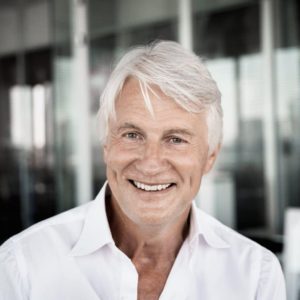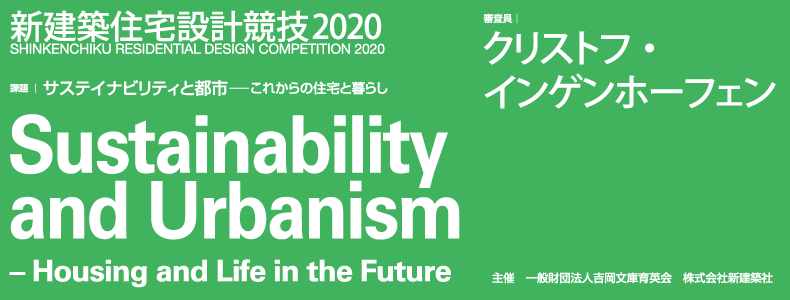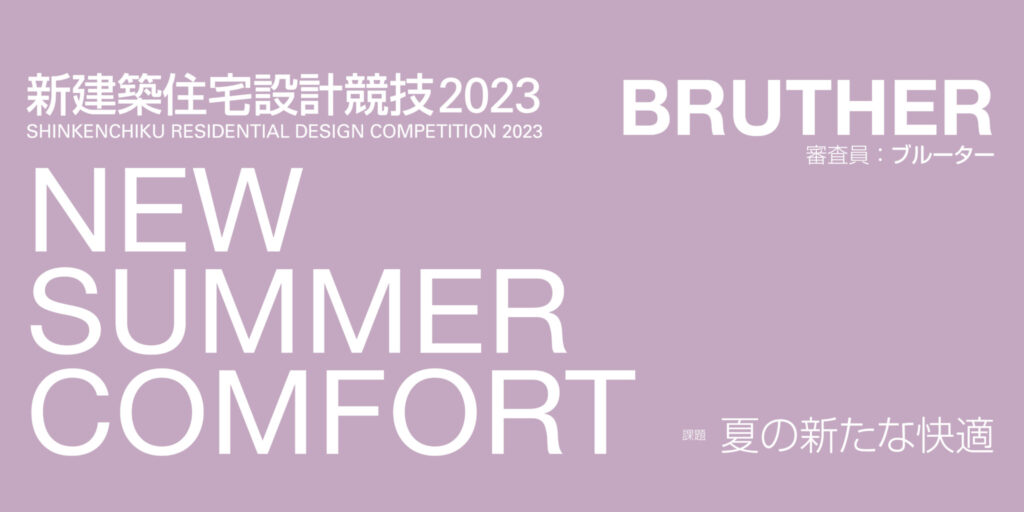新建築住宅設計競技2020 サステイナビリティと都市──これからの住宅と暮らし
テーマ サステイナビリティと都市──これからの住宅と暮らし
21世紀の建築がすべきこととは? 世界人口は2050年までに93億人に達すると推測されています。その予測を信じるとすれば、人口の大部分が大都市に集中し、中には人口1億人にもなる巨大都市も現れると考えられます。同時に、二酸化炭素排出量の80%は都市部が占めているという事実があります。そこで将来的に必要になってくるのが、超高密度の中での暮らしを可能にする新しい都市型建築です。東京、上海、ニューヨークは上手く機能している例といえるでしょう。一方で、コロナ危機やそれに伴うソーシャルディスタンス(社会的距離)を受けて、都市についての新しい考え方も求められるでしょう。最近の出来事の中で、巨大都市の脆弱性が浮き彫りとなっています。
しかし、ひとつ明らかなことがあります。それは、この惑星の資源と調和しながら再び生活できるような住宅や建物をつくらなければいけない、ということです。世界の廃棄物の50%と消費エネルギーの大部分は建設工事や建物運用によるものです。つまり、建築家として、われわれは決定的な違いをもたらすことができるのです。
サステイナブルな建築を生み出すべく努力する中、長きにわたり、単なる技術的な側面のみに焦点が当てられてきました。しかし、これからはもっと全体的な視点を取り入れるべきです。
私のつくった造語で「スーパーグリーン(supergreen)」というものがあります。サステイナビリティの評価が高いことが明らかであるプロジェクトや、間接的に「グリーン」とみなされるような要素を促進するプロジェクトのことを指す単語です。密度を増していく都市について考える時、私が最も重要視しているものは「公共空間」、もっと抽象的に言えば、「社会的な問い」です。優れた建築がいかに新しい解を見つけ出すか考えてみてください。今こそ、現状に疑問を呈する時です。既成概念にとらわれない自由な提案を期待しています。
(クリストフ・インゲンホーフェン)
賞金
- 入選賞金数点100万円
※入選点数および賞金の配分は審査員の決定に従います。
スケジュール
- 2020年6月1日 (月)登録開始
- 2020年9月30日 (水)応募登録終了
- 2021年1月1日 (金)入選発表
応募要項
参加登録
登録は、専用WEBページ上の登録フォームから行ってください。必要事項を入力すると、e-mailで登録番号が交付されます。この登録番号は応募にあたって必要となりますので、各人で保存してください。登録番号交付後、登録内容に変更が生じた場合は再度登録を行ってください。また、複数の作品を応募する場合は、その都度登録してください。
・交付後の、登録番号に関する問合せは受け付けません。
・応募登録は当WEBページ以外からはできません。
・携帯のメールアドレスでは登録番号通知メールを受け取れない場合があります。提出物
応募作品:寸法420mm×594mm(JIS規格A2)2枚に、配置図、平面図、立面図、断面図、アクソノメトリックまたは投影図、パース、その他設計意図を説明するに必要と思われる図面や、模型写真、グラフなどの図版、設計主旨(英語または日本語で記すこと)などを各自選択して描いてください。
なお、設計主旨は英文250ワード以内でまとめ、12ポイント以上の大きさで応募作品内に記入してください。また、応募メール本文にも同じ設計主旨を記入して提出してください。
・ファイル形式:PDF形式
・ファイルサイズ:合計10MB以下(2枚でひとつのファイルにまとめること)
・ 応募作品提出時に事前に受け取った登録番号を電子ファイルの名前として使用して下さい。
(例:skc0000.pdf)応募方法
登録完了メールで指定されたアドレス宛に以下の形式でお送り下さい。
①メールタイトルは「登録番号(半角英数)/新建築住宅設計競技2020応募案」
②応募作品を添付(ファイル容量にご注意下さい。規定外の作品は審査対象外となります。)
③メール本文には、登録書類:登録番号・応募者全員の氏名、年齢、職業/代表者の住所、電話番号、ファックス番号、e-mailアドレス、設計主旨(250ワード以内)を順に記入してください。
注意)応募締切間際は回線の混雑が予想されます。お早めの応募をお願いします。
なお回線混雑による提出遅れにつきましては対応しかねますのであらかじめご了承下さい。入選発表
月刊『新建築』2021年1月号(2021年1月1日発売)、および月刊『a+u』2021年1月号(2020年12月27日発売)、同誌デジタルデータ、当WEBページを予定しています。
その他
・応募作品の著作権は応募者に帰属しますが、出版権は新建築社が保有します。
・応募作品は入選・選外に関わらず、当WEBページに掲載されることがあります。
・応募要項についての質問は一切受け付けません。要項に書かれている範囲内で応募者が 各自判断してください。
・応募作品は未発表のものに限ります。応募作品の一部あるいは全部が、他者の著作権を 侵害するものであってはいけません。また、雑誌や書籍、WEBページなど、著作物から 複写した画像を使用しないこと。著作権侵害の恐れがある場合は、主催者の判断により入 選を取り消す場合があります。
・受賞作品につきましては、掲載時に新たに応募データを送っていただきます。
・応募に関する費用はすべて応募者が負担してください。
・応募作品は各自で内容を確認の上、お送りください。応募後の作品差し替えは不可とします。
・文字化け、リンク切れにご注意ください。リンクファイルは埋め込みとしてください。
・規約に反するものは受理できない場合があります。
審査委員
クリストフ・インゲンホーフェン審査委員
サステイナブルな建築に取り組む国際的な建築家。1960年ドイツ、デュッセルドルフに生まれる。1978~1984年アーヘン工科大学で学び、1980~1981年デュッセルドルフ芸術アカデミーでハンス・ホライン教授に師事し建築を学ぶ。1984年ウォルフガング・デーリング教授のもとで学位を取得する。ドイツサステイナブル建築協会(DGNB)、建築文化のための連邦基金(Federal Foundation for Building Culture)などの建築協会・連盟の創設メンバーである。1985年よりデュッセルドルフの建築事務所であるインゲンホーフェン・アーキテクツを率いる。サステイナブル、利便性、施工性のほか、光や空間にたいしても深く配慮した建築を多く設計している。事務所の仕事のほか、さまざまなコンペの審査員、世界中での講演活動を行なっている。
総評
Competition 2020 Sustainability and Urbanism: Jury Report

Christoph Ingenhoven Jury Member
What should 21st century architecture do? The world’s population will rise to 9.3 billion by 2050. Most of them, if we can believe the prognoses, will live in big cities. Some will live in mega cities with up to 100 million inhabitants. At the same time, cities are responsible for 80% of carbon dioxide emissions. In the future, we will require an urban building culture that allows for incredibly dense living. Tokyo, Shanghai or New York are well-functioning contemporary examples.
However, current events illustrate how vulnerable mega cities are. Do we require a new mode of thinking in the wake of the COVID-19 crisis and the social distancing that ensued? These are the questions posed to the seventy-eight participants in this competition.
I selected works, which address the important social issues arising from the crisis, and had a remarkable approach to providing answers and solutions. After the first review, I shortlisted twelve projects, which deal mainly with three concepts: Future Housing, Future urbanism and Utopia/ Science Fiction. Multiple entries displayed the integration of design elements that actively contribute to sustainability or social return. As all selected winners had an individual approach and a different answer to the questions, I chose to award five projects equally and without additional ranking.
I really appreciate all the great ideas and effort that went into the submitted works and hope that we will continue working on the concepts to create answers to the questions of the future.
[124] Ark the shelter for living + working + supply: This project addresses the complex issue of the Covid-19 pandemic and other pandemic events. The proposal on the one hand is part of the highly dense city network but on the other hand provides a complex mixed-use micro community solution that can act independently from the wider community if needed. I appreciated the well-chosen construct of a new way of living+working+supply in populated cities, to cope with potential public health problems, caused by large population aggregation.
[204] House with Growth: This project is a fictional future answer to a rising population. The competitor faces the problem with a self-growing house. The project combines a modular system with a public space and platformed farmland that gives the area build on back to the community.
[146] Artificial invasion of nature: This proposal makes it clear that greening in architecture is mandatory and can be added to existing buildings as such re-greening the city.
[220] Urban Resource House: The forward-thinking proposal presents an urban resource house, which would produce its own resources for a given radius of population. They answer a challenging question how to supply resources to a deifying urban population without compromising the natural environment. Through this concept, they influence the community and the transportation ways, which has a big impact on climate change and sustainability.
[111] Vertical Urban Village: This clever housing unit is an interplay between a lively community and sustainability. This modular system is built on four important concepts: structure, living, farming and public spaces. This concept should encourage resource reusing and energy efficiency. It’s a smart proposal, which could have been further enhanced by integrating working spaces.
[241] Void-Volume: This work is worth a special mention, because of the creative idea facing the society with the problems we have / (recourse’s we spend). It’s not an answer to the questions, but an interesting, attention-grabbing work, which should be appreciated in its development and idea.

